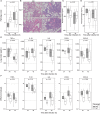Tenascin-C Deficiency Is Associated With Reduced Bacterial Outgrowth During Klebsiella pneumoniae-Evoked Pneumosepsis in Mice
- PMID: 33776992
- PMCID: PMC7990887
- DOI: 10.3389/fimmu.2021.600979
Tenascin-C Deficiency Is Associated With Reduced Bacterial Outgrowth During Klebsiella pneumoniae-Evoked Pneumosepsis in Mice
Abstract
Tenascin C (TNC) is an extracellular matrix glycoprotein that recently emerged as an immunomodulator. TNC-deficient (TNC-/-) mice were reported to have a reduced inflammatory response upon systemic administration of lipopolysaccharide, the toxic component of gram-negative bacteria. Here, we investigated the role of TNC during gram-negative pneumonia derived sepsis. TNC+/+ and TNC-/- mice were infected with Klebsiella pneumoniae via the airways and sacrificed 24 and 42 h thereafter for further analysis. Pulmonary TNC protein levels were elevated 42 h after infection in TNC+/+ mice and remained undetectable in TNC-/- mice. TNC-/- mice showed modestly lower bacterial loads in lungs and blood, and a somewhat reduced local-but not systemic-inflammatory response. Moreover, TNC-/- and TNC+/+ mice did not differ with regard to neutrophil recruitment, lung pathology or plasma markers of distal organ injury. These results suggest that while TNC shapes the immune response during lipopolysaccharide-induced inflammation, this role may be superseded during pneumosepsis caused by a common gram-negative pathogen.
Keywords: Klebsiella pneumoniae (K. pneumoniae); alarmins; immune system; innate immunity; mice; pneumonia; sepsis; tenascin C.
Copyright © 2021 Meijer, de Vos, Scicluna, Roelofs, Abou Fayçal, Orend, Uhel and van der Poll.
Conflict of interest statement
The authors declare that the research was conducted in the absence of any commercial or financial relationships that could be construed as a potential conflict of interest.
Figures



Similar articles
-
Platelet and endothelial cell P-selectin are required for host defense against Klebsiella pneumoniae-induced pneumosepsis.J Thromb Haemost. 2015 Jun;13(6):1128-38. doi: 10.1111/jth.12893. Epub 2015 Apr 23. J Thromb Haemost. 2015. PMID: 25773400
-
Tenascin C Has a Modest Protective Effect on Acute Lung Pathology during Methicillin-Resistant Staphylococcus aureus-Induced Pneumonia in Mice.Microbiol Spectr. 2021 Sep 3;9(1):e0020721. doi: 10.1128/Spectrum.00207-21. Epub 2021 Jul 28. Microbiol Spectr. 2021. PMID: 34319124 Free PMC article.
-
Coagulation factor XI improves host defence during murine pneumonia-derived sepsis independent of factor XII activation.Thromb Haemost. 2017 Jul 26;117(8):1601-1614. doi: 10.1160/TH16-12-0920. Epub 2017 May 11. Thromb Haemost. 2017. PMID: 28492700
-
Function of SLAM-Associated Protein (SAP) in Acute Pneumoseptic Bacterial Infection.J Mol Biol. 2019 Oct 4;431(21):4345-4353. doi: 10.1016/j.jmb.2019.07.002. Epub 2019 Jul 8. J Mol Biol. 2019. PMID: 31295456 Free PMC article. Review.
-
Expression and immune function of tenascin-C.Crit Rev Immunol. 2011;31(2):115-45. doi: 10.1615/critrevimmunol.v31.i2.30. Crit Rev Immunol. 2011. PMID: 21542790 Review.
Cited by
-
Myeloid liver kinase B1 contributes to lung inflammation induced by lipoteichoic acid but not by viable Streptococcus pneumoniae.Respir Res. 2022 Sep 12;23(1):241. doi: 10.1186/s12931-022-02168-6. Respir Res. 2022. PMID: 36096803 Free PMC article.
-
Respiratory Commensal Bacteria Increase Protection against Hypermucoviscous Carbapenem-Resistant Klebsiella pneumoniae ST25 Infection.Pathogens. 2022 Sep 19;11(9):1063. doi: 10.3390/pathogens11091063. Pathogens. 2022. PMID: 36145495 Free PMC article.
-
Cardiovascular changes after pneumonia in a dual disease mouse model.Sci Rep. 2022 Jul 1;12(1):11124. doi: 10.1038/s41598-022-15507-w. Sci Rep. 2022. PMID: 35778475 Free PMC article.
-
Advances on the roles of tenascin-C in cancer.J Cell Sci. 2022 Sep 15;135(18):jcs260244. doi: 10.1242/jcs.260244. Epub 2022 Sep 14. J Cell Sci. 2022. PMID: 36102918 Free PMC article.
-
Animal models of Klebsiella pneumoniae mucosal infections.Front Microbiol. 2024 Mar 15;15:1367422. doi: 10.3389/fmicb.2024.1367422. eCollection 2024. Front Microbiol. 2024. PMID: 38559342 Free PMC article. Review.
References
Publication types
MeSH terms
Substances
LinkOut - more resources
Full Text Sources
Other Literature Sources
Medical
Molecular Biology Databases
Miscellaneous

